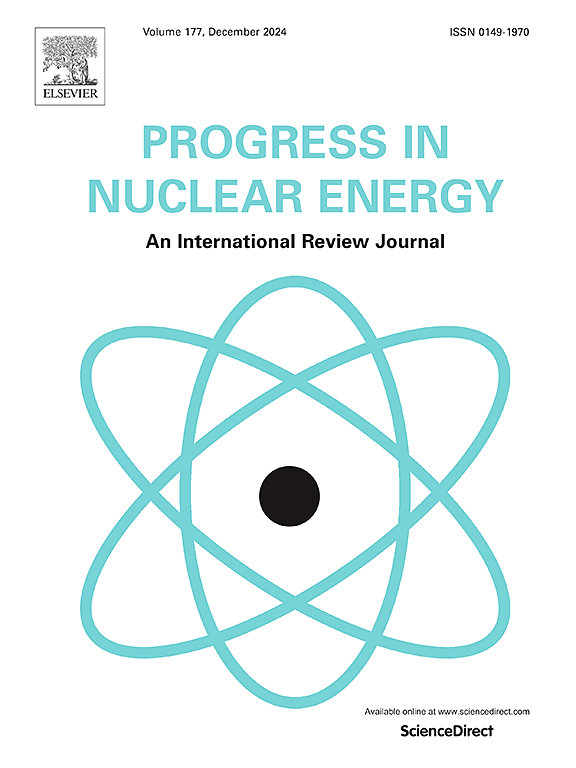高普朗特数氟化物盐在卵石床通道内流动和传热特性的数值研究
IF 3.2
3区 工程技术
Q1 NUCLEAR SCIENCE & TECHNOLOGY
引用次数: 0
摘要
氟盐冷却高温反应堆(FHRs)为高温工业应用和发电提供了有前途的能源选择。由于熔盐的高普朗特数和球床结构,氟化物盐在球床堆芯中的热水力特性复杂。对堆芯的研究对堆芯的设计和安全运行具有重要意义。本文采用计算流体力学方法研究了含氟盐在卵石床通道中的流动和传热,雷诺数范围为50 ~ 600。结果表明,层流-过渡流和过渡流-湍流的临界雷诺数分别为100和180。旋涡结构的演变对流动特性有显著影响,直接影响湍流强度分布,从而影响流动过渡过程。在层流状态下,鹅卵石之间狭窄的缝隙严重阻碍了流体的流动,导致缝隙附近出现局部热点,流体温度升高。增加雷诺数可以减轻这种影响,从而大大降低温度峰值,使温度分布更加均匀。在较低雷诺数条件下,已有的球床流动和传热关系式与数值计算结果存在较大偏差,在此基础上建立了基于模拟数据的新关系式。该研究可为堆芯堆的设计和运行提供重要的热水力数据和经验关联。本文章由计算机程序翻译,如有差异,请以英文原文为准。
Numerical research of flow and heat transfer characteristics of high-Prandtl-number fluoride salt in the pebble bed channel
Fluoride-salt-cooled High-temperature Reactors (FHRs) offer promising energy options for high-temperature industrial applications and electricity generation. The thermal-hydraulic characteristics of fluoride salt in the pebble bed reactor core are complex due to the molten salt's high Prandtl number and pebble bed structure. The research on it is important for the design and safe operation of the FHR reactor core. This work investigates the flow and heat transfer of fluoride salt in the pebble bed channel through computational fluid dynamics, with the Reynolds number ranging from 50 to 600. The results reveal that the critical Reynolds numbers for the laminar-to-transitional and transitional-to-turbulent flow regimes are 100 and 180, respectively. The evolution of vortex structures significantly influences the flow characteristics, directly impacting the turbulence intensity distribution and, consequently, the flow transition process. In the laminar regime, the narrow gaps between pebbles severely hinder fluid flow, leading to localized hot spots and elevated fluid temperatures in the vicinity of the gaps. Increasing the Reynolds number mitigates this effect, resulting in substantially reduced temperature peaks and a more uniform temperature distribution. Existing pebble-bed flow and heat transfer correlations show considerable deviation from the present numerical results at lower Reynolds numbers, with the new correlations developed based on the simulation data. This work can provide important thermal-hydraulic data and empirical correlations for the FHR reactor design and operation.
求助全文
通过发布文献求助,成功后即可免费获取论文全文。
去求助
来源期刊

Progress in Nuclear Energy
工程技术-核科学技术
CiteScore
5.30
自引率
14.80%
发文量
331
审稿时长
3.5 months
期刊介绍:
Progress in Nuclear Energy is an international review journal covering all aspects of nuclear science and engineering. In keeping with the maturity of nuclear power, articles on safety, siting and environmental problems are encouraged, as are those associated with economics and fuel management. However, basic physics and engineering will remain an important aspect of the editorial policy. Articles published are either of a review nature or present new material in more depth. They are aimed at researchers and technically-oriented managers working in the nuclear energy field.
Please note the following:
1) PNE seeks high quality research papers which are medium to long in length. Short research papers should be submitted to the journal Annals in Nuclear Energy.
2) PNE reserves the right to reject papers which are based solely on routine application of computer codes used to produce reactor designs or explain existing reactor phenomena. Such papers, although worthy, are best left as laboratory reports whereas Progress in Nuclear Energy seeks papers of originality, which are archival in nature, in the fields of mathematical and experimental nuclear technology, including fission, fusion (blanket physics, radiation damage), safety, materials aspects, economics, etc.
3) Review papers, which may occasionally be invited, are particularly sought by the journal in these fields.
 求助内容:
求助内容: 应助结果提醒方式:
应助结果提醒方式:


